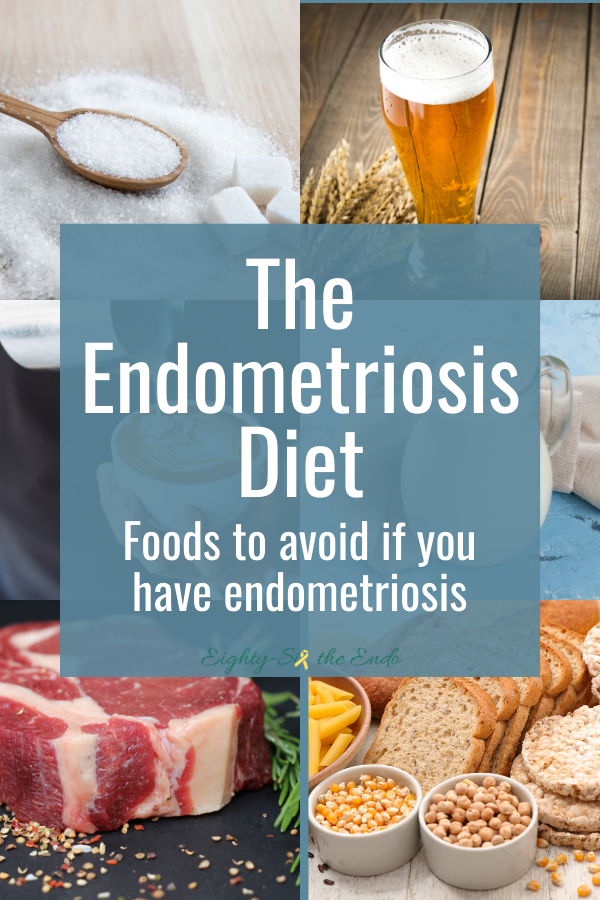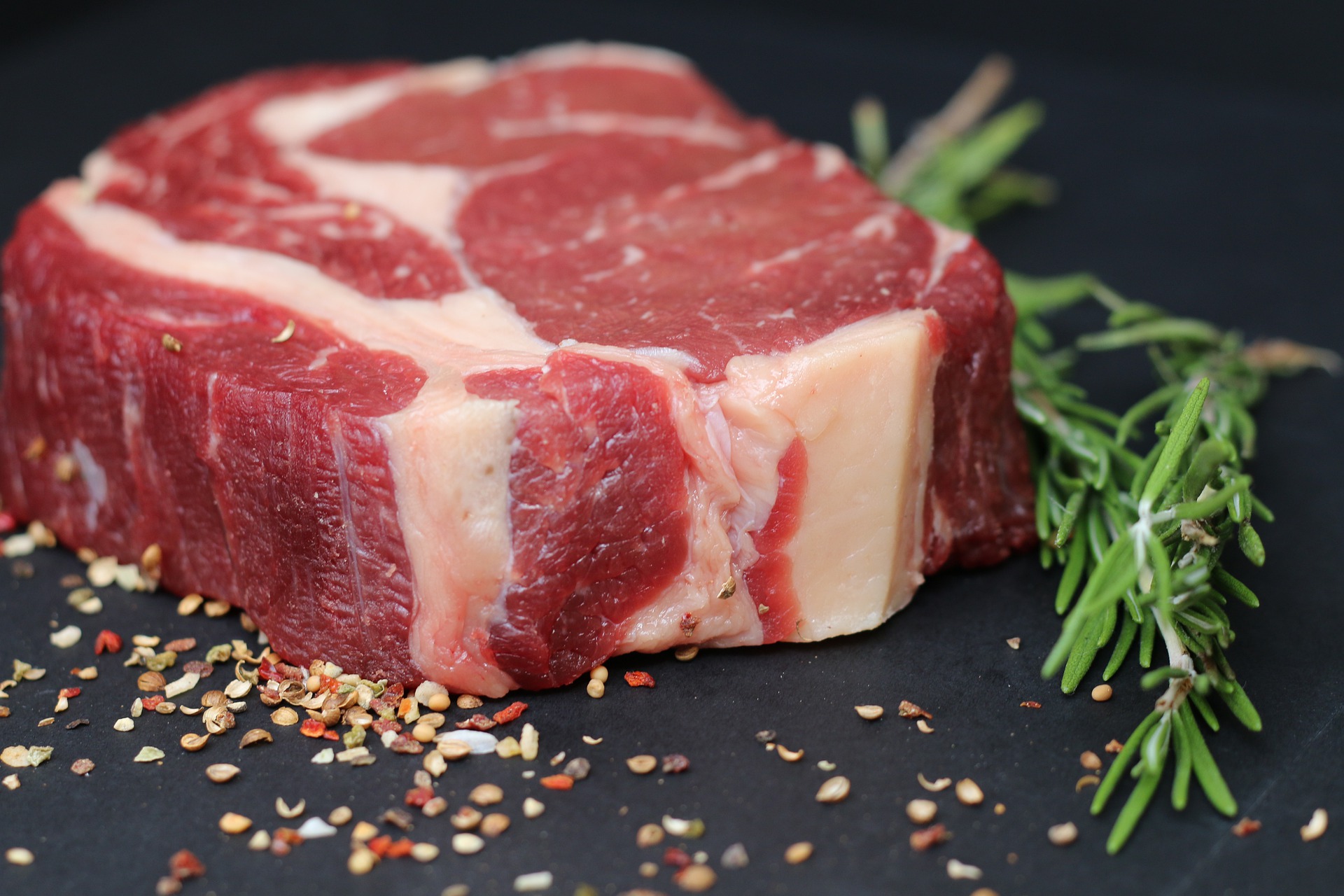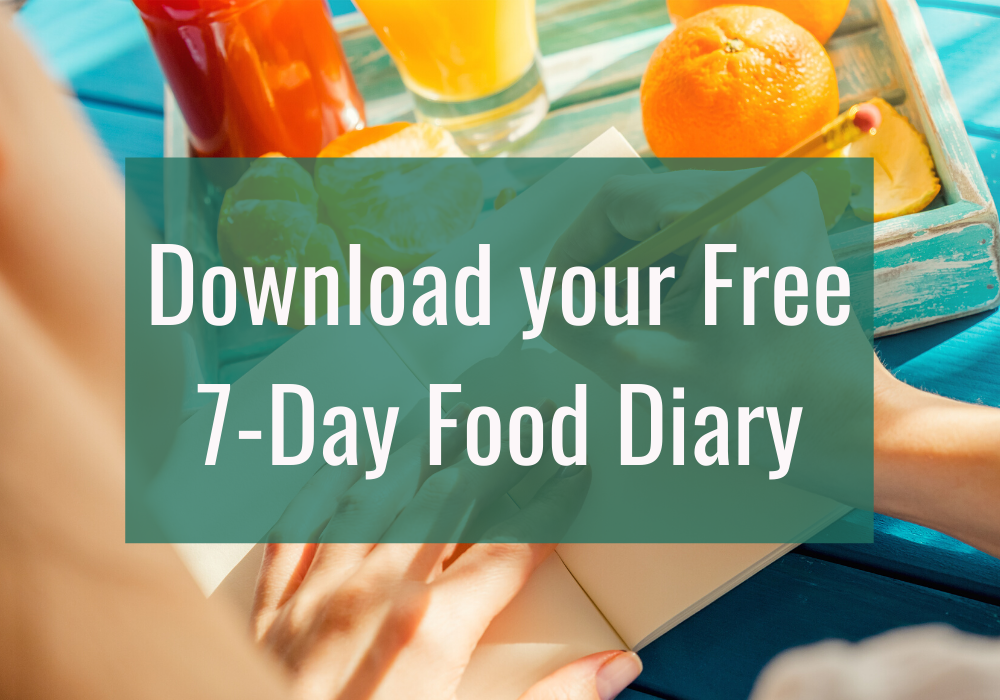It is widely known that a healthy diet full of fruits, vegetables, and lean protein leads to better overall health. Generally, most people know that they should avoid fast foods, processed foods, and excessive sugar consumption. This is no different for the endometriosis warrior who may find some relief in symptoms when following the Endometriosis Diet, or their own variation of it.
But first, I’d like to take a moment to discuss this idea of the endometriosis diet. There are countless online resources that layout the foods that you should avoid with endometriosis, calling it The Endometriosis Diet. But what so many of these resources fail to mention is the indisputable fact that endometriosis affects everyone differently. And so, it is so important to acknowledge that one particular diet may not affect you the same way it affects someone else.
Even more so, it is vital that you understand that a diet free of food triggers is not a cure to endometriosis; and your diet is not the cause of your disease. And although endometriosis does not have a cure, a holistic and integrative approach to the disease can certainly help reduce symptoms and provide you with a better quality of life (9).
Why Should You Evaluate Your Diet?
Aside from the gold standard treatment of laparoscopic excision, and pelvic floor physical therapy, diet has been proven to help endo warriors in diminishing symptoms; especially those that affect the gut.
Endometriosis is a chronic systemic disease in which cells similar to the ones found on the uterine wall are found in other areas of the body. This leads to symptoms including, but not limited to, chronic pelvic pain, debilitating periods, pain with bowel movements or urination, pain with sex, and infertility. Endometriosis is also an inflammatory disease that worsens when introduced to other inflammatory materials, like certain foods, drinks, or even environmental estrogens.
Therefore, eliminating trigger foods and inflammatory foods from your diet is one way to help reduce symptoms, progression of the disease, and overall pain. While it will take time to feel the difference in symptoms, you may find that it is worth it.

A Diet Just For You
Before I get into the common inflammatory foods that are usually avoided on the endometriosis diet, I feel it’s important to talk about the elimination diet. Unlike other diets, an elimination diet is not used to lose weight. Although weight loss may be a byproduct of the diet, it is best recognized as a way to improve overall health and diminish unwanted symptoms. It does this by removing foods that the body may be sensitive to; foods that are known to cause inflammation.
So, while the endometriosis diet can be a great place to start, the best individual outcomes come from a combination of the endo diet and an elimination diet. This ideal combination leaves you with an individualized diet that supports you as you face life with endometriosis.
Completing An Elimination Diet
As I am not a dietitian or nutrition coach, I don’t think it’s wise or ethical for me to lay out an elimination diet plan for you.
Though there are clear benefits to completing an elimination diet, optimal results come from working with a qualified professional (a registered dietitian or certified nutritionist). Having a professional walk you through the process will give you the support you need, as it is undoubtedly a long and difficult process. Not only will they give you the support you need, but they will also help identify areas where you are lacking nutrients and minerals.
However, if you don’t have the funds or resources to get professional help, I recommend you do your due diligence in researching all the elements of completing an elimination diet. I admittedly completed mine on my own after reading the book The Elimination Diet.
Regardless, if you choose to complete an elimination diet on your own, I recommend you at least avoid purchasing home food sensitivity kits, like the Everly Well Food Sensitivity test. Not only are these tests expensive, but home food sensitivity kits are testing the wrong antibodies and have been proven to be an ineffective way to diagnose food sensitivities (8).
Food Journaling
Finally, before I get into the common foods to avoid on an endometriosis diet, I want to touch on a final suggestion. Regardless of whether you choose to use a professional or not, there is one place I recommend starting before making any diet changes. That is, I recommend you start a food diary.
A food diary will help you take note of the foods and drinks you consume on a regular basis. This will give you, or the professional you are working with, an idea of where to start and where you might be nutritionally deficient. Charting this will also help you identify what foods may be causing flares in your symptoms.
To help you, I have created a free downloadable 7-Day Food Diary, which you can print multiple times (as needed).
The Endometriosis Diet
As I’ve discussed already, inflammation is a direct contributor to the symptoms that occur with Endometriosis. Steroidal hormones can also be a factor in the progression of endometriosis. So, it only makes sense that the endometriosis diet consists of eliminating foods that are known to initiate the inflammatory process or effect hormonal status.
But again, it’s important to remember that we all are unique when it comes to how endometriosis manifests. While some of these foods can help eliminate symptoms for most people, they may have no effect on you. Listen to your body and determine what foods are YOUR triggers.
Ultimately, it will be your decision to eliminate or reduce your consumption of these and other foods. At the end of the day, you are the one who must follow this diet, so make sure it is a diet that you are comfortable with maintaining. And if you have a meal that contains any of your triggers, give yourself some grace. No one is perfect.

Dairy
Dairy is known to be inflammatory for most people. Many adults have difficulty breaking down or digesting lactose and casein, which are both found in milk. They both can also cause unwanted symptoms due to irritation to the bowel and irritation to endometriosis lesions on the bowel; symptoms like bloating, diarrhea, constipation, and nausea (9).
Not only do we know the potential inflammatory effects of dairy, but most dairy farms are now injecting their cattle with hormones and antibiotics that will eventually reach the consumer. Since endometriosis is already poorly effected by hormonal imbalance, you may find it extremely beneficial to eighty-six the dairy!
Luckily, we are in a new era where it is extremely easy to find non-dairy alternatives. My favorite is cashew milk. I find that it has the most similar taste and consistency to cow’s milk.

Gluten
Another food product that should be eliminated, or at least avoided, is gluten.
While navigating through my new diagnosis of Endometriosis, I found that eliminating gluten from my diet had me feeling less overall pelvic pain, less bloating, less headaches, more energy, and a sharper mind.
A study done in 2012, came to a similar conclusion after having their participants follow a gluten free diet for 1 year. At the end of the year, seventy-five percent of the patients had a decrease in pain (3). So, what are you waiting for? Eighty-Six the gluten.
Gluten proteins are found in wheat, barley, rye, triticale and oats (unless they are certified GF oats). Common foods that contain these products are breads/baked goods, pastas, crackers, cereals, dressings/condiments, beer, malts, soups.
But don’t worry, there are more foods that do not contain gluten than you think. There is a world of gluten-free, whole foods that are rich in vitamins, nutrients, and proteins. Following a gluten free diet is difficult at first, but over time, you will find amazing and delicious alternatives.

Red Meat
In one study conducted from 1991 through 2013, the researchers “observed that red meat, both processed and nonprocessed, was associated with an increased risk of laparoscopically confirmed endometriosis” (4).
And just like dairy, red meat is typically sourced from animals that have been injected with countless hormones and antibiotics, which can wreak havoc on your endocrine (hormone) system.
If you are an omnivore, and have no trigger in symptoms with red meat, reducing your red meat consumption is still helpful to your endo. And when purchasing red meat, choose lean meat that is organic, grass-fed, and free-range (9). For those who choose to eliminate red meat altogether, yet still want to consume animal proteins, you can opt for pasture-raised poultry that has been raised without added antibiotics, hormones, and steroids.

Sugars
Although there are countless studies that identify sugar as highly inflammatory, one study found sugar intake was especially high in beverages (5). This same study explained that, after sugar consumption, the free fatty acids produced in the liver may act as a trigger to inflammation (5).
Rule of thumb: Avoid foods and drinks with added sugars. This includes coffee creamers, sodas, juices, and even alcoholic cocktails, as they can all be harmful to the Endo Warrior.
Alternatively, opt for natural sugars when you have a sweet tooth or find foods that use natural sweeteners like: fruits, dates, organic honey, organic maple syrup, pure monk fruit sweetener, and stevia. But still, be mindful of the quantity of natural sugars used.

Alcohol
Speaking of alcoholic cocktails. . . I love a good Margarita! But I was not surprised when I learned that I should avoid them all together. Everytime I have a margarita, I develop a headache within 30 minutes of drinking it. It is also quickly followed by severe pelvic cramping that disrupts the rest of my day.
Avoiding alcohol relates back to why you should avoid sugars. Most alcoholic beverages have excessive amounts of added sugars in them. Likewise, alcohol is stored in the body as fat (triglycerides), which puts stress on the liver and can trigger the same cascade of inflammatory processes as sugar. To top it off, many alcoholic beverages have been made with gluten-filled ingredients.
All in all, avoiding or limiting your alcohol intake can really make a difference in your symptoms.
Caffeine
This one was the hardest for me, as I couldn’t seem to give up coffee. For the longest time, I told myself that coffee is not a trigger for me. However, at the beginning of 2020, I realized that it does cause my menstrual cramping to be worse if I drink caffeine the few days before my period and throughout menstruation. I was in denial, but I eventually came to realize my truth. Since this realization, I have opted for infrequent decaf coffee, for when I am really craving it.
Despite my experience, its recommended that caffeine be eliminated if you have endometriosis. Not only does caffeine exacerbate the inflammatory process, it also effects the digestive system; commonly causing cramping and diarrhea.
If you would like to decrease your caffeine intake without the headaches from caffeine withdrawals, try drinking green tea and decrease the amount of green tea you have each day until you can comfortably omit it.

Processed/High-Fat Foods
One study states that frequent high-fat food intake is linked to inflammation in the entire body (6). It also concluded that high-fat diets resulted in “increased inflammatory markers within the peritoneum;” which is where endometriosis is commonly found (6).
Processed foods fall into the realm of high-fat foods most of the time, but on their own, it’s important to remember that processed foods usually have wheat (gluten), dairy, soy, and added sugars.

Soy
Endometriosis is known to be an estrogen-dependent disease. Since soy is a plant-based estrogen (or phytoestrogen), it’s no wonder that so many Endo Diet articles warn against soy. However, in a study done in 2016, researchers found no evidence to signify an association between phytoestrogens and risk of endometriosis (7).
Additionally, there is research that has helped scientist realize that not all endometriosis lesions are only estrogen-dependent; as some are more influenced by Progesterone. That being said, there is still so much research that needs to be done. And as endo warriors, we need to be cautious and mindful of that fact.
Despite this, soy is still known to be a crop that is oftentimes genetically modified, heavily sprayed with pesticides, and highly processed. So even though there is no clear answer as to whether its phytoestrogen content is harmful to endometriosis patients, its still smart to avoid soy when possible.
If you decide to eliminate soy, just remember that it is found in so many foods and reading ingredient lists is imperative. Soy is in condiments, meat alternatives, dairy alternatives, protein powders, Asian foods, nutrition supplements, seasonings, candy . . . the list goes on. Read, read, read your labels!
Disclosure: This post may contain affiliate links. I earn from qualifying purchases. This comes at no extra cost to you and I only recommend products that I believe will be valuable to my audience.
Final Note:

- Bordoni, A., Danesi, F., Dardevet, D., Dupont,D., Fernandez, A.S., Gille, D., Nunes dos Santos, C., Pinto, P., Re, R., Rémond, D., Shahar, D.R., & Vergères, G. (2017). Dairy products and inflammation: A review of the clinical evidence. Critical Reviews in Food Science and Nutrition, 57(12), 2497-2525. DOI: 10.1080/10408398.2014.967385
- Melnick, B.C. (2009). Milk – The promoter of chronic Western diseases. Medical Hypotheses, 72(6), 631-639. https://doi.org/10.1016/j.mehy.2009.01.008
- Lazzaro, A., Lazzaro, S., Marziali, M., Micossi, C., Stolfi, V.M., & Venza, M. (2012). Gluten-free diet: a new strategy for management of painful endometriosis related symptoms? Minerva Chirurgica, 67(6):499-504. https://www.ncbi.nlm.nih.gov/pubmed/23334113
- Chavarro, J.E., Harris, H.R., Missmer, S.A., Vitonis, A.F., Yamamoto, A. (2018). A prospective cohort study of meat and fish consumption and endometriosis risk. American Journal of Obstetrics and Gynecology, 219(2), 178.e1-178.e10. https://doi.org/10.1016/j.ajog.2018.05.034
- Della Corte, K. W., Perrar, I., Penczynski, K. J., Schwingshackl, L., Herder, C., & Buyken, A. E. (2018). Effect of Dietary Sugar Intake on Biomarkers of Subclinical Inflammation: A Systematic Review and Meta-Analysis of Intervention Studies. Nutrients, 10(5), 606. doi:10.3390/nu10050606
- Heard, M. E., Melnyk, S. B., Simmen, F. A., Yang, Y., Pabona, J. M., & Simmen, R. C. (2016). High-Fat Diet Promotion of Endometriosis in an Immunocompetent Mouse Model is Associated With Altered Peripheral and Ectopic Lesion Redox and Inflammatory Status. Endocrinology, 157(7), 2870–2882. https://doi.org/10.1210/en.2016-1092
- Mumford, S. L., Weck, J., Kannan, K., & Buck Louis, G. M. (2016). Urinary Phytoestrogen Concentrations Are Not Associated with Incident Endometriosis in Premenopausal Women. The Journal of nutrition, 147(2), 227-234.
- The Myth of IgG Food Panel Testing. Retrieved from https://www.aaaai.org/conditions-and-treatments/library/allergy-library/IgG-food-test#.Wx3GPqNGRnk.gmail
- Luyendyk, E. (n.d.). Nutrition for Endometriosis. Center for Endometriosis Care: A Legacy of Excellence in Endometriosis Care. Retrieved from http://centerforendo.com/diet





Thank you so much for your blog post! Yours is the first one I’ve ever read that actually acknowledges that some people’s endometriosis symptoms do not respond, or are not triggered by some foods. All other posts that I have read say to stick to a strict diet and leave no room for leeway. I have stage 2 endo and have found that most of my symptoms do not correlate with what I eat. I’ve cut out everything from gluten and dairy to caffeine, meat, and even cutting out gluten free options on bread, pasta, etc. None of that changed my symptoms, so now I eat the foods that I love in moderation and balance. Your post was so helpful, encouraging and refreshing and I just wanted to say thank you!
I am so happy you found it helpful and inclusive! I really appreciate your feedback 🙂